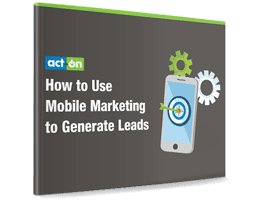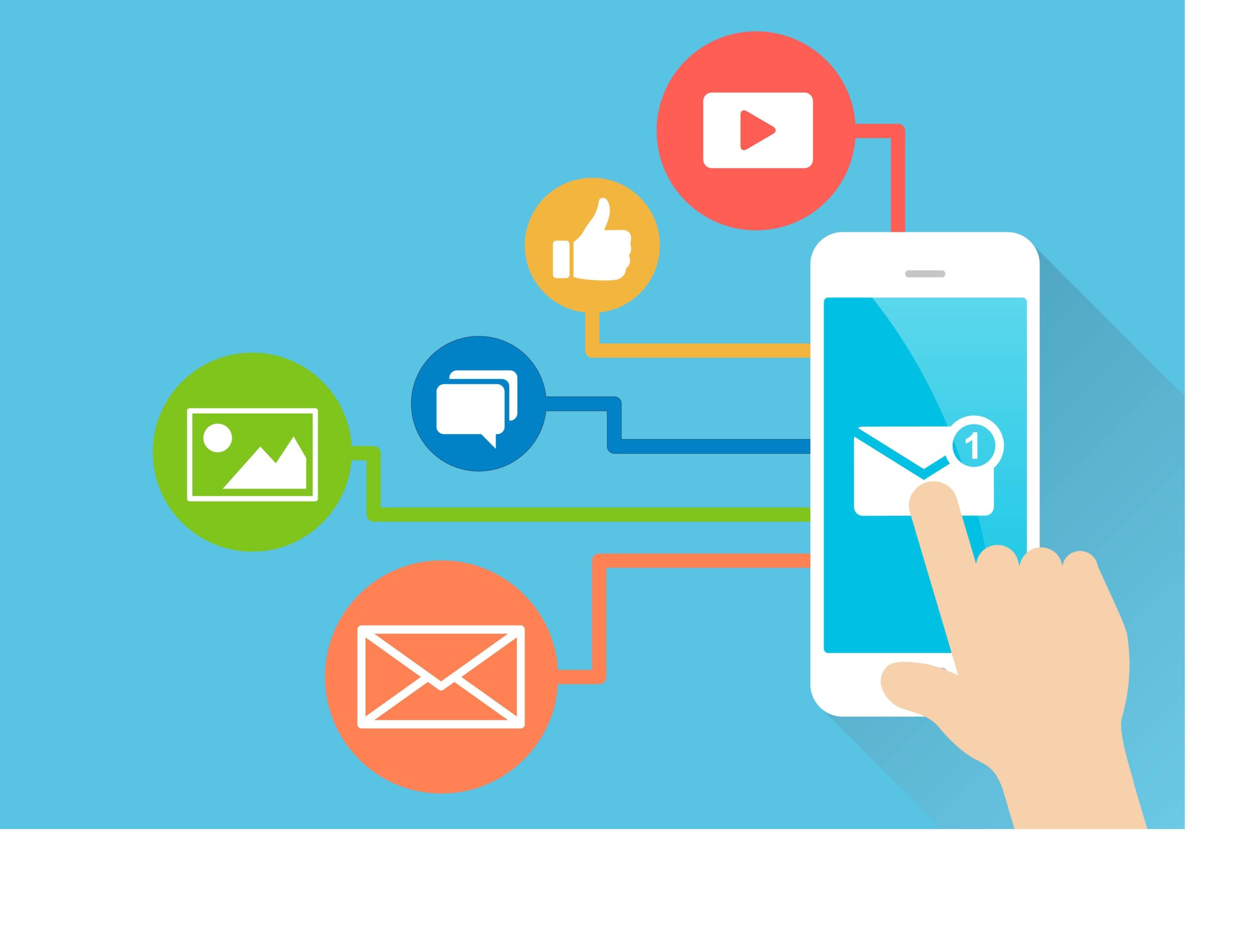Have you ever wondered how to use mobile marketing for a B2B lead generation campaign?
If you’re like many B2B marketers, you probably thought mobile was a B2C tool, not a B2B tool. The truth is that mobile is a very effective B2B lead generation tool – if you know how to use it. The problem is that many people are confused by mobile and, quite frankly, a little intimidated by it.
Fear not – what follows is an introductory guide to help you understand the landscape and put it into use for your business.
Ready to go mobile? Let’s dive right in.
Top Seven Mobile Marketing Channels for B2B Marketers:
Mobile Optimized Websites: Many people tend to think of apps as the foundation of mobile marketing; however, before you begin exploring the idea of creating an app, make sure your website is optimized for mobile use. It’s one of the first places a customer will interact with your brand, so if it’s not already optimized for a smartphone or tablet, you’ll want to jump on that right away. Responsive design is the best choice for making your website mobile-friendly, for most marketers.
The idea of creating a mobile website shouldn’t be daunting, just remember to keep things simple and streamlined since many people visiting your mobile site will be … well, mobile.
Mobile Optimized Email
We’re sure you’re already using email as part of lead generation campaigns, but is your email template optimized for mobile? Today, more emails are opened on mobile than on desktop, and using the desktop template means a bad experience for your recipient.
Most marketing automation platforms (like Act-On) provide mobile template options, so making the switch is often as easy as the click of a button.
Mobile Paid Search
More searches today take place via mobile than desktop. Setting up a mobile paid search campaign is a great way for you get in front of prospects right when they’re looking for your product or service. This is especially important if you’re marketing to a local audience.
Many companies report higher click-through and engagement rates on their mobile search campaigns. Furthermore, most mobile search ads have a click-to-call feature, which lets prospects connect to businesses instantly.
Mobile Display Ads
Over the past few years, display ad formats have evolved from static banners to rich media ads designed to engage your prospects. With options like click-to-call, click-to-download, click-to-video, and click-to-social, mobile display gives your prospects multiple ways to interact with your brand.
Furthermore, targeting options like geo-fencing and geo-targeting let advertisers serve ads within a radius that they define. This, in turn, minimizes waste while ensuring mobile ads are delivered to the right audience. Again, this is especially important if your audience is local.
Mobile Apps
If you’re thinking you’ll make a billion dollars off your mobile app idea, we’re here to burst your bubble. Odds are, you’re not. However, apps are a great way for B2B marketers to deepen their engagement with current customers and demonstrate their value to prospects.
 For example, suppliers can make the ordering process super easy for their customers by creating a streamlined app. Creating an ROI calculator or legal compliance app is a great way to get your brand front of prospects, too. The bottom line – apps can be a great way to keep prospects engaged with your brand, but they’re probably not going to be your road to riches.
For example, suppliers can make the ordering process super easy for their customers by creating a streamlined app. Creating an ROI calculator or legal compliance app is a great way to get your brand front of prospects, too. The bottom line – apps can be a great way to keep prospects engaged with your brand, but they’re probably not going to be your road to riches.
Short Message Service (SMS)
While SMS has been around for a while, it doesn’t get as much attention as other mobile marketing channels. However, with a 99% open rate on messages, it’s one that should definitely be a part of your mobile marketing toolkit.
SMS marketing can be used to direct prospects to content on your website or to inform them about current promotions. Just keep in mind that the SMS messages are even shorter than Twitter messages. Also ensure that your prospects have opted-in to receive messages, so that your campaign adheres to the SMS-marketing standards set by the FCC. (Get the Mobile Marketing Association’s Text Marketing Initiative – Messaging in the Marketing Mix Strategic Framework v2.0 for a full rundown on best practices.)
Proximity Marketing and/or Location-Based Marketing
To get even more granular with targeting, you can use Proximity Marketing or Location-based Marketing to target people within a few yards of your business (Proximity Marketing) or within a 5-mile radius (Location-Based Marketing).
Proximity marketing uses technologies such as WiFi, beacons, and near field communications to target users in a tightly defined space. The applications of these technologies are endless
— you can display messages at a trade show or enhance the client’s experience when they visit your office. Proximity Marketing platforms include Apple’s iBeacon, Hotspot Revenue’s TalkingWiFi, and Google’s Eddystone.
In the past, the term Location-based Marketing was used to describe apps like Yelp, Instagram, and Foursquare. Today, it’s also used to describe using geo-locational targeting to deliver marketing messages to a tightly defined area.
As an example, let’s say you want to run a mobile display campaign to target businesspeople in the San Francisco Bay Area. That could be considered a Location-based Marketing campaign because it focuses on a tightly-defined geographic area. Mobile companies that can deliver a Location-based Marketing campaign include 4INFO (for mobile display), SlickText (for SMS) and Google Adwords (for paid search).
Now that you’re fairly acquainted with the top mobile marketing options for B2B marketers, let’s go over an action plan so you can get started with your own mobile campaign.
Five Step Mobile Action Plan
Step 1: Optimize Your Website for Mobile
 Check your site on your smartphone or tablet right now. If it doesn’t render correctly or has too much information on it, it’s time to optimize it for mobile. Unsure if your website is optimized? Then you can use Google’s mobile website tool to see how your website performs on mobile.
Check your site on your smartphone or tablet right now. If it doesn’t render correctly or has too much information on it, it’s time to optimize it for mobile. Unsure if your website is optimized? Then you can use Google’s mobile website tool to see how your website performs on mobile.
Mobile optimization doesn’t have to be overly complex. There are many firms that specialize in website mobilization, such as Blue Train Mobile and Otreva, that can help you optimize your website.
Step 2: Set Up Mobile Paid Search
If you’re already running a paid search campaign, make sure that your ads are showing up on mobile (in addition to desktops and tablets). Also add in your address and phone number, as these are often displayed as a part of the paid search ad unit.
Before launching the campaign, be sure to check that all landing pages render correctly on smartphones and tablets.
Step 3: Set Up Mobile Display Campaign
Add mobile to your existing display campaigns or set up a mobile campaign if you’re currently not running a desktop campaign.
With self-serve platforms, such as Google’s AdWords, you can easily set-up geo-targeted and behaviorally targeted campaigns, which reach users in a specific area and users that are looking for products or services like yours respectively.
To get more granular with your targeting by using geo-fencing and location-based marketing, you’ll want to use a vendor that specializes in mobile advertising, such as 4INFO.
Step 4: Optimize All Webforms for Mobile
Now that you’ll direct users from their smartphones to your webpage, make sure that all forms are optimized for mobile.
In addition to checking whether your forms render correctly, you’ll want to keep them simple and include only the most important fields.
Step 5: Optimize Email for Mobile
As mentioned earlier, more and more users are opening their emails on mobile today, so using email-optimized templates is an absolute must. Also, keep your emails concise and include a clear call to action. Make your call to action a button large enough so a user can hit it with ease; text links can be frustrating. Finally, use a single column template and keep your font large, so that it can be read easily on smartphone screens.
 The five steps outlined above are a foundation for a strong B2B mobile marketing campaign. Once these pieces are in place, we encourage you to explore SMS, apps, and proximity marketing for your lead generation campaigns.
The five steps outlined above are a foundation for a strong B2B mobile marketing campaign. Once these pieces are in place, we encourage you to explore SMS, apps, and proximity marketing for your lead generation campaigns.
Have questions about mobile marketing? Feel free to tweet me @AskJamieTurner. Or download a copy of Act-On’s eBook – How to Use Mobile Marketing to Generate Leads, to learn nine steps for generating leads on mobile.
Jamie Turner is an internationally recognized author, entrepreneur and CNN contributor. Jamie will be sharing his top B2B mobile marketing secrets at the Mobile X Festival in May, 2016.

